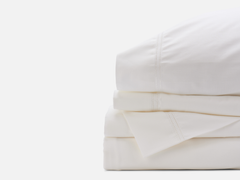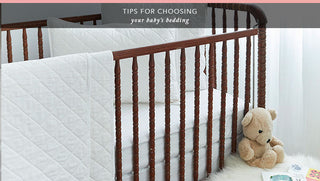Bringing your baby home for the first time is one of the most wonderful and terrifying moments of your life. You never thought you could love someone so much, so you want to do everything just right. That means the right food, the right toys, and especially the right bedding. Let’s make one thing clear: you won’t get everything perfect as a parent, and that’s ok! However, you can do your best with what’s in front of you. Our tips for choosing your baby’s bedding are here to help you do just that.
Sheets
Tightly Fitted
When we go to sleep, we don’t think twice about piling on as many blankets, comforters, and duvets as we can (especially when it gets chilly out). But putting blankets in a baby’s crib is dangerous if they’re under a year old. Blankets create a suffocation risk for newborns. When choosing your baby’s bedding, stick to a tightly-fitted sheet over the mattress. If you’re using older sheets, make sure you double-check the elastic so when you tuck it under the mattress, it’ll stay there.
Breathable
Babies are so little that it’s easy to worry about them getting too cold, but usually, the biggest risk is them getting too warm. That’s because newborns have trouble regulating their own body temperature. So, when you go to choose a sheet to put on your baby’s bed, opt for a lighter, more breathable material. This will keep your babies cool and comfortable all night long. 100% cotton sheets are recommended by most experts for being breathable and hypoallergenic (and, honestly, we have to agree).
Gentle
“Smooth as a baby’s bottom”—we all know the saying; you only have to hold a baby once to know it’s true. Babies have very soft, sensitive skin. Make sure the sheets you choose are going to be as gentle on your baby’s skin as you would be. Keep in mind, though, that gentle doesn’t necessarily mean “soft.” Remember, we want the material to be as breathable as possible, and sometimes soft can be smothering. Look for a material that’s kind to the skin, but don’t break your neck trying to find the highest possible thread count either.
Washable
We’re sure you don’t need us to tell you that taking care of a baby can get, well, messy. From spilled bottles to other kinds of spilled liquid, the last thing you want is a material that doesn’t wash well. Check the material and the washing instructions before you buy the sheets. Resist the urge to throw up your hands and buy disposable ones. They may be durable, but they’re no replacement for a reliable cotton bedsheet.
Mattress
Firm
New parents are usually prepared to deal with how fragile a baby is. But there are plenty of little ways that babies are more durable than we give them credit for. For example, their bones. Baby bones aren’t as brittle as ours are. That’s why little kids can get up and laugh from falls that would’ve laid us up for weeks. Because of that, baby mattresses must be firmer. The firmness helps support your baby’s bones, especially as they get to the point of wanting to push themselves upright. Don’t worry if the mattress feels like something you would never sleep on. Your baby will sleep just fine.
Of course, by the time your baby is a toddler, they’re ready for a mattress that’s a little bit softer. One way to save money later is to buy a stage two mattress. These mattresses are firmer on one side and softer on the other. That way, when your baby gets a little older, all you have to do is flip the mattress.
A Quick Test
Not sure if your baby mattress is firm enough? Press down on the mattress in several places. It should press down under your weight without conforming to the shape of your hand. If your hand leaves an indent, then the bed is too soft.
Mattress Covers
Again, baby raising is a messy business, and even mamas and papas with the sharpest diaper changing reflexes can’t guarantee there won’t be spills. To keep your baby’s sleep space as hygienic as possible, use a waterproof mattress cover. This will keep stains from setting in and make clean up quicker and easier. It also helps to keep your mattress in better shape which is important if you want to hang on to your mattress for your next baby.
Certifications
Advertisements make a lot of claims about a product, but it would be nice if we could get an outsider’s opinion. Fortunately, you can get an outsider’s opinion of your crib mattress without only looking at reviews online. There are a whole slew of organizations out there with standards on crib mattress safety. Companies who have mattresses that meet their standards will usually proudly display them. Mattresses that meet certifications are usually safe and tested for harmful chemicals.
Extras
Rail Guard Covers
Sooner than you’re ready for it, your baby will be teething. That means they’ll put anything they can grab into their mouth, including the crib’s railing. While you can’t stop your baby from trying to gnaw their way out of their crib, you can make it safer by putting a rail covering on the side of their crib. Since teething and standing go hand in hand, a rail covering will also help keep your baby from hitting their head on the side of the crib.
Skip Baby Bumpers
One piece of baby bedding you should consider skipping is the baby bumper. Baby bumpers are pieces of fabric you place along the side of the crib to keep your baby getting stuck between the rails of the crib. These pieces typically do more harm than good, especially since modern cribs are built with the railings closer together to keep babies from getting stuck.
We all want to do right by our babies. And although no one’s a perfect parent, we can do the best with what’s in front of us by trying to pick quality crib bedding. Our baby bedding made in the USA is light, breathable, and 100% cotton—just the thing to make that first night at home as perfect as your baby.









